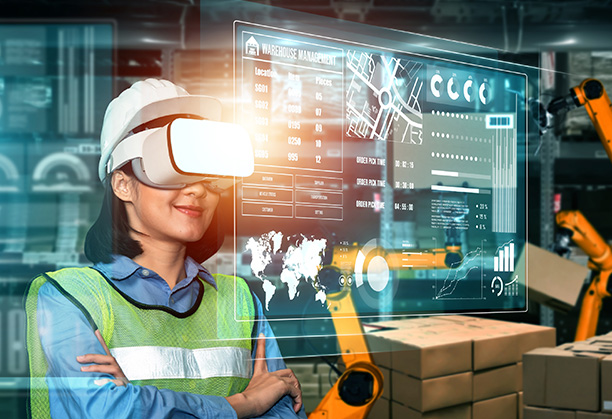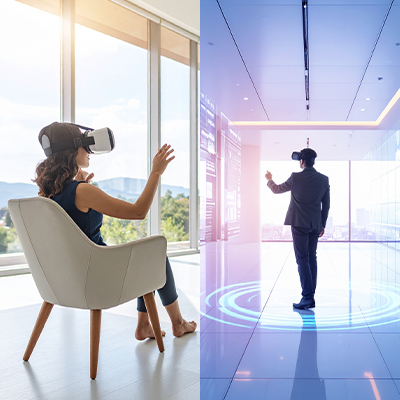Many companies today face common workplace challenges, including training programs that fail to engage employees, safety procedures that are difficult to implement, and remote teams that struggle to collaborate effectively. Traditional methods often prove too costly and fail to deliver the results businesses need. Virtual reality in the workplace provides a practical solution to these problems by creating realistic, interactive experiences that enhance learning, improve safety, and foster team collaboration. This guide outlines seven clear ways VR can address real-world workplace problems, saving money and strengthening results for your business.
The Rise of VR in the Workplace
Virtual Reality (VR) has moved beyond gaming and entertainment to become a useful business tool. More companies are incorporating virtual reality (VR) into their workplaces because it helps address real-world problems and enhances work efficiency.
VR creates computer-generated environments that feel real. Workers can see, hear, and interact with these virtual spaces as if they were actually there. This technology helps businesses train employees more effectively, make workplaces safer, and enable teams to work together even when they’re far apart.
The benefits of using VR in the workplace are clear: training costs less money, employees remember what they learn better, safety improves, and workers stay more engaged. As VR equipment becomes more affordable and user-friendly, an increasing number of businesses are incorporating it into their daily operations.
7 Ways Businesses Use VR in the Workplace
1. Corporate Training and Onboarding
Immersive training in the workplace makes training more engaging and effective by allowing employees to practice in realistic virtual environments. New workers can tour virtual offices, learn company policies, and practice their job tasks before performing them for real.
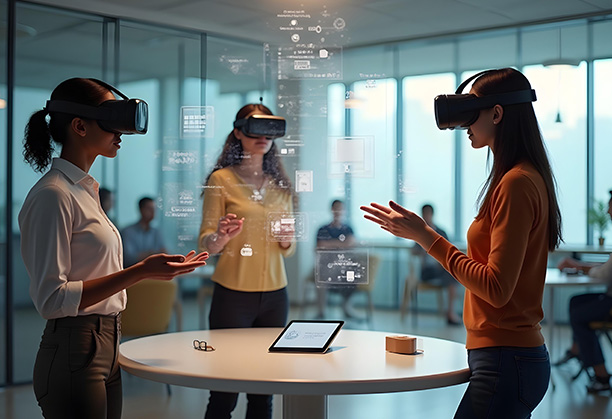
What VR training in the workplace can do:
- New employee training: Virtual office tours and company training that keeps people interested
- Job skills practice: Learning to use equipment and tools safely in virtual space
- Communication skills: Practicing presentations in front of virtual audiences to reduce nervousness
- Understanding differences: Experiences that help employees understand different perspectives
Companies like Siemens cut their training time by more than half using VR. Other businesses utilize VR to help employees improve their public speaking and presentation skills.
2. Workplace Safety and Compliance
VR helps workers practice dangerous situations safely. Instead of risking real accidents, employees can learn safety procedures in virtual environments where mistakes don’t cause harm.
Safety training uses:
- Emergency practice: Fire drills, chemical accidents, and emergency exits
- Equipment training: Learning to use dangerous machinery safely
- Emergency response: What to do in crisis situations
- Rule compliance: Learning and following safety regulations
This works especially well in construction, manufacturing, and healthcare, where safety training used to be expensive or risky for workers to practice.
3. Remote Collaboration and Virtual Workspaces
VR helps remote teams work together better by creating virtual meeting spaces where everyone can meet, even when they’re in different locations. These virtual offices feel more natural than regular video calls.
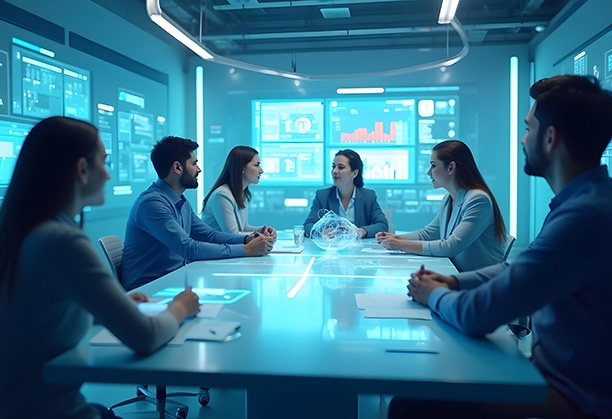
How teams can work together:
- Virtual meetings: Meeting rooms where people can talk and work together naturally
- Shared workspaces: Places where teams can design and plan projects together
- Global teamwork: People from different countries and time zones working on the same project
- Better presentations: Showing ideas and data in 3D ways that are easier to understand
Companies like Meta and Microsoft have created VR meeting platforms that make remote work feel more connected and productive.
4. Product Design, Prototyping, and Development
VR accelerates product development by enabling teams to create and test virtual versions of products before building real ones. This saves time and money while making better products.
Product development uses:
- Virtual prototypes: Testing products in 3D before making them
- Comfort testing: Making sure products are comfortable and easy to use
- Team reviews: Having different departments look at and improve designs together
- Assembly testing: Practicing how to build products before actual production
Car companies like Hyundai and BMW use VR to design and test their vehicles. Airplane maker Boeing also uses it, which helps them create better products faster and more cost-effectively.
5. Customer Service and Sales Enhancement
VR improves customer service by helping employees practice dealing with customers in realistic situations. It also creates exciting ways to show products to potential buyers.
Customer service improvements:
- Service practice: Learning how to handle demanding customers and solve problems
- Virtual showrooms: Showing products in interactive 3D environments
- Sales training: Practicing sales conversations and handling customer questions
- Product education: Teaching complex products in easy-to-understand ways
These VR applications enable companies to deliver improved customer service and increase sales by making interactions more engaging and memorable.
6. Maintenance and Operations
VR helps businesses run more smoothly by training workers to fix and maintain equipment without stopping production. Workers can practice on virtual machines before working on real ones.
Operations improvements:
- Equipment repair: Learning to fix machines in virtual environments
- Problem solving: Practicing how to find and solve technical problems
- Remote help: Getting expert guidance through VR when fixing equipment
- Process improvement: Finding better ways to do work by testing in virtual environments
This is especially helpful for businesses with expensive equipment, such as factories, power plants, and transportation companies, where downtime can be costly.
7. Employee Wellbeing and Mental Health
VR supports employee mental health and wellness by providing relaxing experiences that help workers manage stress and stay focused during the workday.
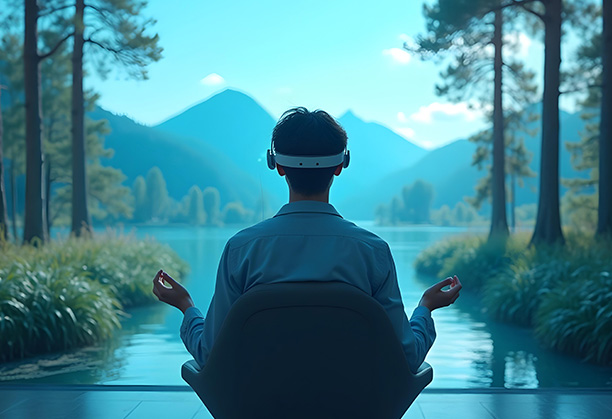
Wellness applications:
- Stress relief: Guided relaxation and meditation experiences
- Mental health support: Calming environments for managing anxiety and stress
- Focus training: Breathing exercises and concentration techniques
- Work breaks: Virtual nature experiences and relaxing activities
Companies like Dropbox have started using VR wellness programs, and they report that employees are happier and take fewer sick days due to stress.
Ready to transform your workplace with VR?
How Juego neXR Can Help
We create custom VR solutions tailored to your specific business needs, help you set everything up properly, train your staff to utilize the technology, and provide ongoing support to ensure everything works smoothly.
Our team has helped companies improve their training by 75%, reduce workplace accidents by 50%, and increase employee engagement by 40%. Whether you want better training programs, safer workplaces, or more effective team collaboration, Juego neXR has the experience and technology to help your business succeed with virtual reality.
Conclusion
Virtual reality is transforming the way businesses operate by addressing common workplace challenges in innovative and effective ways. The seven uses explained in this guide demonstrate how VR can enhance training, safety, teamwork, and employee satisfaction while reducing costs and improving outcomes. As the use of VR and AR in the workplace continues to expand, companies are discovering new applications and benefits that drive innovation and competitive advantage.
VR technology is continually improving and becoming more affordable, so companies that adopt it now will have a competitive advantage over their competitors. They’ll have better-trained employees, safer workplaces, and more innovative ways to serve customers.
Frequently Asked Questions
You’ll need VR headsets, compatible computers or mobile devices, and VR software applications. Basic setups can begin with standalone headsets, such as Meta Quest, while more advanced applications may require high-end, PC-connected headsets. Most businesses begin with a few devices for pilot programs before expanding.
Initial costs range from $1,000 to $10,000 for basic setups to over $ 50,000 for comprehensive programs. However, VR training typically pays for itself within 6-12 months through reduced traditional training costs, fewer safety incidents, and improved employee productivity. Many companies achieve 30-50% cost savings over the long term.
Yes, studies show VR training in the workplace improves knowledge retention by 75-90% compared to traditional methods. Employees stay more engaged, practice skills safely, and remember information longer. Companies report faster skill development, reduced training time, and better performance outcomes with VR-based learning programs.
Manufacturing, healthcare, construction, retail, education, and customer service see the most significant benefits. Any job involving equipment operation, safety procedures, customer interaction, or complex training scenarios works well with VR. Remote teams and companies with multiple locations also benefit significantly from virtual reality (VR) collaboration tools.
Most employees learn basic VR operation within 15-30 minutes. Full comfort with VR applications typically develops within 1 to 2 hours of use. Younger employees often adapt more quickly, but training programs can be tailored to accommodate all age groups. The intuitive nature of modern VR makes adoption easier than most expect.
Revolutionize the future of business with Juego neXR
Related Posts
Share this Article:
Our Offices

India
Bangalore
GR Grand Plaza, 2nd Floor, JP Nagar, 6th Phase, Bangalore – 560 078

KSA
Jeddah
St Idris Square, 4036 Helmi Koutbi, Al Zahra, Jeddah 23425, Saudi Arabia
Follow Us On:
© 2025 Juego neXR. All Rights Reserved.
